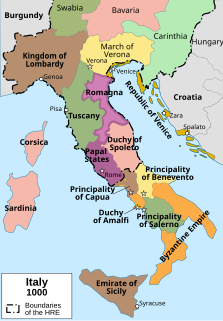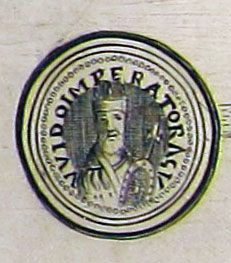
Louis II, sometimes called the Younger, was the king of Italy and Holy Roman Emperor from 844, co-ruling with his father Lothair I until 855, after which he ruled alone. Louis's usual title was imperator augustus, but he used imperator Romanorum after his conquest of Bari in 871, which led to poor relations with the Eastern Roman Empire. He was called imperator Italiae in West Francia while the Byzantines called him Basileus Phrangias. The chronicler Andreas of Bergamo, who is the main source for Louis's activities in southern Italy, notes that "after his death a great tribulation came to Italy."

The Duchy of Spoleto was a Lombard territory founded about 570 in central Italy by the Lombard dux Faroald. Its capital was the city of Spoleto.

The Duchy of Benevento was the southernmost Lombard duchy in the Italian Peninsula that was centred on Benevento, a city in Southern Italy. Lombard dukes ruled Benevento from 571 to 1077, when it was conquered by the Normans for four years before it was given to the Pope. Being cut off from the rest of the Lombard possessions by the papal Duchy of Rome, Benevento was practically independent from the start. Only during the reigns of Grimoald, King of the Lombards and the kings from Liutprand on was the duchy closely tied to the kingdom. After the fall of the kingdom, however, alone of Lombard territories it remained as a rump state and maintained its de facto independence for nearly 300 years though it was divided after 849.

Lambert was the King of Italy from 891, Holy Roman Emperor, co-ruling with his father from 892, and Duke of Spoleto and Camerino from his father's death in 894. He was the son of Guy III of Spoleto and Ageltrude, born in San Rufino. He was the last ruler to issue a capitulary in the Carolingian tradition.

Guy III of Spoleto was the margrave of Camerino from 880 and then duke of Spoleto and Camerino from 883. He was crowned king of Italy in 889 and emperor in 891. He died in 894 while fighting for control of the Italian Peninsula.

Pandulf I Ironhead was the Prince of Benevento and Capua from 943 until his death. He was made Duke of Spoleto and Camerino in 967 and succeeded as Prince of Salerno in 977 or 978. He was an important nobleman in the fight with the Byzantines and Saracens for control of the Mezzogiorno in the centuries after the collapse of Lombard and Carolingian authority on the Italian Peninsula. He established himself over almost the whole of the southern half of Italia before his death in March 981.

Sico was the Lombard Prince of Benevento from the 817 to his own death.
Guaimar I was the prince of Salerno from 880, when his father entered the monastery of Monte Cassino in August. His parents were Prince Guaifer and Landelaica, daughter of Lando I of Capua. From 877, he was associated with his father on the throne, a practice which had begun with the previous dynasty and continued until the end of Salernitan independence in 1078.
Landulf II was Bishop and Count of Capua. He was the youngest of four sons of Landulf I, gastald of Capua. As a young man, he entered the church. When his father died, his eldest brother, Lando, succeeded him.
Landulf IV was the prince of Capua and Benevento from 968, when he was associated with his father, Pandulf Ironhead, and prince of Salerno associated with his father from 977 or 978. In 968, his uncle Landulf III died and this was the occasion of his rise, as Pandulf ignored the rights of Landulf's son Pandulf, his nephew, and instead associated his own son with the government.
Alberic I was the Lombard Duke of Spoleto from between 896 and 900 until 920, 922, or thereabouts. He was also Margrave of Camerino, and the son-in-law of Theophylact I, Count of Tusculum, the most powerful man in Rome.

Adelchis was the son of Radelchis I, Prince of Benevento, and successor of his brother Radelgar in 854.
Lando I was the count of Capua from 843. He was the eldest son and successor of Landulf the Old. Like his father, he supported Siconulf against Radelchis in the civil war dividing the Principality of Benevento in the 840s.
Lando III was the count of Capua for two years and ten months from 882 to his death. He was a son of Landenulf, gastald of Teano, and grandson of Landulf I of Capua.
Guy IV was the Duke of Spoleto and Camerino from 889 and Prince of Benevento from 895. He was the son of Guy II of Spoleto.
Guy II was the eldest son and successor of Lambert I as Duke of Spoleto and Margrave of Camerino. He was elected to succeed to these titles on his father's death in 880. He had an ambitious plan of expansion to the south and to the west that conflicted with the Papacy.
Ageltrude was the Empress and Queen of Italy as wife and mother respectively of Guy and Lambert. She was the regent for her son and actively encouraged him in opposing her archenemies, the Carolingians, and in influencing papal elections in their favour.
The Landulfids or Atenulfings were a noble family of Lombardic origin in the ninth through eleventh centuries. They were descended from Landulf I of Capua, whose own ancestry is unknown and who died in 843. The dynasty produced a line of princes which ruled most of southern Italy at one time or another and even one pope, Victor III.

The Emirate of Bari was a short-lived Islamic state ruled by Berbers. It was ruled from the south Italian city of Bari from 847 to 871. It was the most lasting episode in the history of Islam in peninsular southern Italy.
The Frankish emperor Louis II campaigned against the Emirate of Bari continuously from 866 until 871. Louis was allied with the Lombards of southern Italy from the start, but an attempt at joint action with the Byzantine Empire failed in 869. In the final siege of the city of Bari in 871, Louis was assisted by a Slavic fleet from across the Adriatic.